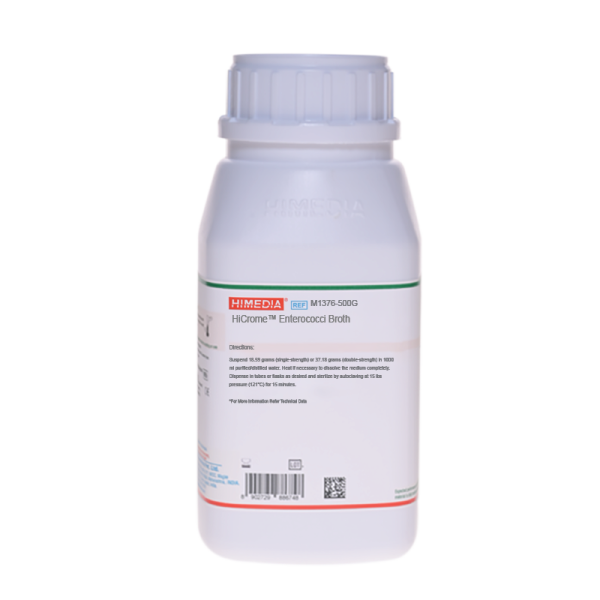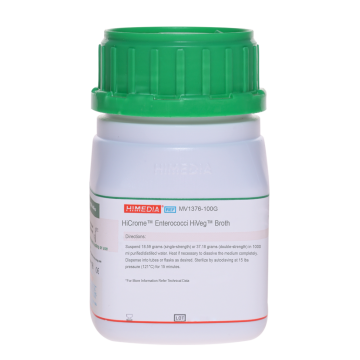 Your enquiry has been submitted
Your enquiry has been submitted
HiCrome™ Enterococci Broth
Intended use
Recommended for identification and differentiation of Enterococci from water samples.
Composition**
| Ingredients | g/L |
|---|---|
| Peptone, special | 10.000 |
| Sodium chloride | 5.000 |
| Sodium azide | 0.300 |
| Chromogenic substrate | 0.040 |
| Polysorbate 80 (Tween 80) | 2.000 |
| Disodium hydrogen phosphate | 1.250 |
Final pH (at 25°C): 7.5±0.2
**Formula adjusted, standardized to suit performance parameters
Directions
Suspend 18.59 gram (single-strength) or 37.18 grams (double-strength) in 1000 ml purified/distilled water. Heat if necessary to dissolve the medium completely. Mix well and dispense as desired and sterilize by autoclaving at 15 lbs pressure (121°C) for 15 minutes.
Principle And Interpretation
HiCrome™ Enterococci Broth is formulated on the basis of the work carried out by Althous et al (1), Amoras (2), Litsky et al (3), and Manafi and Sommer (4) and Snyder and Lichstein (5). These media is recommended for the rapid detection of Enterococci from water samples. The presence of Enterococcus group, which is a subgroup of the faecal Streptococci, serves as a valuable bacterial indicator for determining the extent of faecal contamination (1,6) and it is more specific than the detection of coliforms, which may originate from non-faecal sources. The enzyme β-glucosidase produced by Enterococci cleaves the chromogenic substrate, resulting in a bluish green colour.
The medium contains peptone special, which provides carbonaceous, nitrogenous compounds, long chain amino acids, vitamins and other essential nutrients. Sodium chloride maintains the osmotic balance of the medium. Sodium azide inhibits the accompanying microflora, especially gram-negative organisms. Polysorbate 80 acts as a source of fatty acids.
Type of specimen
Water samples
Specimen Collection and Handling:
For water samples, follow appropriate techniques for sample collection, processing as per guidelines and local standards (7). After use, contaminated materials must be sterilized by autoclaving before discarding.
Warning and Precautions :
Read the label before opening the container. Wear protective gloves/protective clothing/eye protection/ face protection. Follow good microbiological lab practices while handling specimens and culture. Standard precautions as per established guidelines should be followed while handling specimens. Safety guidelines may be referred in individual safety data sheets.
Limitations
- Some species may show poor growth due to nutritional variations.
- Slight colour variations may be observed depending upon the utilization of the substrate by the organism.
- Further biochemical and serological test are need to be carried out for confirmation.
Performance and Evaluation
Performance of the medium is expected when used as per the direction on the label within the expiry period when stored at recommended temperature.
Quality Control
Appearance: Cream to yellow homogeneous free flowing powder
Colour and Clarity of prepared medium: Light amber coloured, clear solution in tubes
Reaction: Reaction of 1.86% w/v aqueous solution at 25°C. pH: 7.5±0.2
pH: 7.30-7.70
Cultural Response
Cultural characteristics observed after an incubation at 35-37°C for 24-48 hours.
| Organism | Inoculum (CFU) | Growth | Colour of Medium |
|---|---|---|---|
| Escherichia coli ATCC 25922 (00013*) | 50-100 | none-poor | light yellow |
| Enterococcus faecalis ATCC 29212 (00087*) | 50-100 | luxuriant | Light blue-green |
| Pseudomonas aeruginosa ATCC 27853 (00025*) | 50-100 | none-poor | light yellow |
| Staphylococcus aureus subsp. aureus ATCC 25923 (00034*) | 50-100 | Fair-good | light yellow |
Key: (*) Corresponding WDCM numbers.
Storage and Shelf Life
Store between 15-25°C in a tightly closed container and the prepared medium at 2-8°C. Use before expiry date on the label. On opening, product should be properly stored dry, after tightly capping the bottle in order to prevent lump formation due to the hygroscopic nature of the product. Improper storage of the product may lead to lump formation. Store in dry ventilated area protected from extremes of temperature and sources of ignition Seal the container tightly after use. Product performance is best if used within stated expiry period.
Disposal
User must ensure safe disposal by autoclaving and/or incineration of used or unusable preparations of this product. Follow established laboratory procedures in disposing of infectious materials and material that comes into contact with sample must be decontaminated and disposed of in accordance with current laboratory techniques (8,9).
Reference
- Althous, H., Dott, W., Havemeister, G, Muller, H.E, a. Sacre, C., 1982, Zbl. Bakt. Hyg. I. Abt. Orig. A. 252:154-165.
- Amoras I, 1995, Poster presentation congress of Spanish Society of Microbiology, Madrid.
- Litsky, W., Mallmann, W.L., a Fifield, C.W. 1953, Amer. J. Pbl. Hlth. 43:873-879.
- Manafi M., and Sommer R, 1993, Wat. Sci. Tech. 27:271-274.
- Snyder M.L., and Lichstein, H.C. 1940, J. Infect. Dis. 67. 113-115
- Standard Methods for the Examination of Water and Wastewater, 20th Edition, Edited by L.S. Clesceri, A.E. Greenberg and A.D. Eaton, Published by APHA, AWWA and WEF (1998).
- Lipps WC, Braun-Howland EB, Baxter TE, eds. Standard methods for the Examination of Water and Wastewater, 24th ed. Washington DC:APHA Press; 2023.
- Isenberg, H.D. Clinical Microbiology Procedures Handbook 2nd Edition.
- Jorgensen, J.H., Pfaller, M.A., Carroll, K.C., Funke, G., Landry, M.L., Richter, S.S and Warnock., D.W. (2015) Manual of Clinical Microbiology, 11th Edition. Vol. 1.
| Product Name | HiCrome™ Enterococci Broth |
|---|---|
| SKU | M1376 |
| Product Type | HiCrome™ |
| Physical Form | Powder |
| Origin | Animal |
| Packaging type | HDPE |
| References | 1.Althous, H., Dott, W., Havemeister, G, Muller, H.E, a. Sacre,C., 1982, Zbl. Bakt. Hyg. I. Abt. Orig. A. 252:154-165.2.Amoras I, 1995, Poster presentation congress of Spanish Society of Microbiology, Madrid.3.Litsky, W., Mallmann, W.L., a Fifield, C.W. 1953, Amer. J. Pbl. Hlth. 43:873-879.4.Manafi M., and Sommer R, 1993, Wat. Sci. Tech. 27:271-274.5.Snyder M.L., and Lichstein, H.C. 1940, J. Infect. Dis. 6 |
| Customized Product Available | No |






